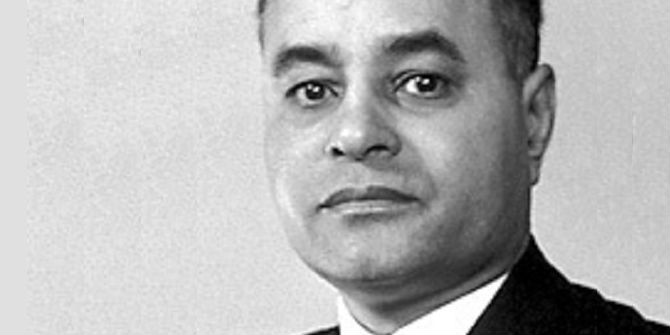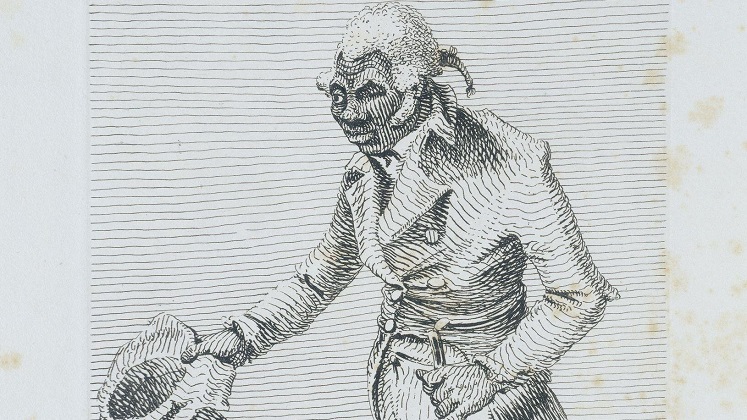Victoria de Menil revisits the politics of Jomo Kenyatta’s supposedly de-political master’s thesis, later published as Facing Mount Kenya, particularly in relation to land and female circumcision. She asks who the intended audience was, and what legacy the book has left behind.
Once upon a time an elephant made a friendship with a man. One day a heavy thunderstorm broke out, the elephant went to his friend, who had a little hut at the edge of the forest and said to him: ‘My dear good man, will you please let me put my trunk inside your hut to keep it out of this torrential rain?’ The man, seeing what situation his friend was in, replied: ‘My dear good elephant, my hut is very small, but there is room for your trunk and myself. Please put your trunk in gently.’ The elephant thanked his friend, saying: ‘You have done me a good deed and one day I shall return your kindness.’
But what followed? As soon as the elephant put his trunk inside the hut, slowly he pushed his head inside and finally flung the man out in the rain.
“Once upon a time” is an unorthodox way to start a dissertation chapter for an anthropologist, but Jomo Kenyatta was an unorthodox student. He began attending seminars at LSE in 1934, at the age of 43, arriving during the soviet famine by way of Moscow State University – a bastion of Communism and an unusual feeder school to LSE. Kenyatta had been involved with the International Trade Union Committee of Negro Workers in Moscow, under the influence of his friend and pan-Africanist George Padmore. But following Hitler’s rise to power in 1933, Stalin reconfirmed Russia’s pact with Germany, and the Comintern dissolved the Committee of Negro Workers. Class, not race conflict, was deemed the source of historical progress.
It is not surprising then that in a letter of recommendation to support his master’s studies, Kenyatta’s supervisor, Bronislaw Malinowski, emphasised his student’s depoliticisation. “[When] Kenyatta started his work at my Department … he had a definitely political bias in all his approach. This, I think, has been almost completely eradicated by the constant impact of detached scientific method on his mental processes. … Another two years of systematic study … will, I am certain, complete the change.” The argument was convincing, and in 1936 the International Institute of African Languages and Culture granted Kenyatta £70 to be delivered in two instalments, covering two years of study. The ensuing thesis was published the year after his diploma as the book Facing Mount Kenya: The Tribal Life of the Gikuyu, an ethnography of Kenya’s largest ethnic group, better known today as the Kikuyu. But was Kenyatta’s politics “completely eradicated?”
Scholarship motivated by politics
Kenyatta’s dedication of the book would suggest otherwise: “To … all the dispossessed youth of Africa: for perpetuation of communion with ancestral spirits through the fight for African Freedom, and the firm faith that the dead, the living, and the unborn will unite to rebuild the destroyed shrines.” The book is suffused with politics, in particular the politics of land return and the question of female circumcision. The story of the elephant, for instance, goes on to tell how the man attempts taking the elephant to court to resolve the dispute. In an Animal-Farm-like sequence, the court, headed by a lion, calls on a committee, composed of a hyena, a rhino, a buffalo, an alligator and a sly fox, who arrive at the verdict that “it is clearly for your good that the space should be put to its most economic use, as you yourself have not yet reached the stage of expansion which would enable you to fill it.” The tale does not lend “economics” a good name.
Kenyatta’s arguments in favour of female circumcision reflect theories of functionalism, a branch of social anthropology, started by Professor Malinowski, which views rituals in terms of the social functions they perform. Female circumcision, also known as clitoridectomy or, in today’s more politicised language, female genital mutilation was ubiquitous in 1930s among the Kikuyu, though its prevalence has dropped among that ethnic group to 21%. Kenyatta defended the practice in the name of supporting the principle of “age-grading” (the organisation of society around age groups) and as a tool for education, particularly teaching endurance. The larger context in which this question arose, however, was around the rights of native Africans to practise their traditions. Hence, in the second edition of Facing Mount Kenya, the subtitle changed from “tribal life” to “traditional life of the Gikuyu.”
The debate on female circumcision (known locally as irua) became heated in 1929, when the mission Church of Scotland in Kenya banned the practice, and furthermore required all of its members to pledge the same. The Kikuyu Central Association retaliated by taking a stand in favour of circumcision. Kenyatta had entered politics through the Kikuyu Central Association, shortly after the protectorate of British East Africa was made into a colony and Kikuyu lands were seized (1920). He later became their general secretary, and it was in that capacity that he made his first trip to London to lobby for the return of Kikuyu lands. His stance on circumcision was therefore informed by a political allegiance and a position against dominance by church and Crown.

Clearly, Kenyatta’s “mental processes” were still under the influence of politics, despite the beneficial effects of anthropological methods. It may be that, to Professor Malinowski, calling Kenyatta depoliticised was a way of observing that they shared the same politics. Malinowski’s own politics are transparent in the introduction: “Do the religious convictions of those who accept Hitler as God, who have faith in the omnipotence of Mussolini or in the omniscience of Stalin, belong to savagery or to civilisation, to superstition or to faith?” The emphasis here is on what Africans can show us about European savagery. In a professorial spirit, however, Malinowski did not refrain from using the introduction to critique his student for “a little too much … European bias.” He took particular issue with the comparison of the tribal specialist in charge of circumcision to a “Harley Street surgeon.”
The European bias was no accident. Kenyatta may have had several audiences in mind, but chief among them was the British, particularly those shaping the views of parliamentarians. Studying at LSE enabled him to master the language of the oppressor so as better to fight it. The language of fight is present in his introduction, when he exclaims in the style of a toast, “I owe thanks also to my enemies, for the stimulating discouragement which has kept up my spirits to persist in the task. Long life and health to them to go on with the good work!” It is almost a truism that the presence of an enemy helps create unity. Against the backdrop of Kenyatta’s imagined opposition, whom he refers to at times as “the Europeans,” he shifts, in the book’s conclusion, into decidedly un-anthropological language. No longer are we talking of the Kikuyu, but now of “the African,” a term that unmasks his political leanings towards pan-Africanism.
Arriving at independence
A diploma in anthropology did not succeed in “completing the change” towards depoliticisation that Malinowski announced in his letter of recommendation. After publishing the book (which initially sold only 517 copies, although sales have now caught up with history), Kenyatta went on to continue lobbying on behalf of the Kikuyu in London. He spent the war years in the UK working as a farm-hand, and lecturing on the side. He also became involved with a group of pan-Africanists, including Padmore, Banda (future president of Malawi) and Nkrumah (another LSE graduate and future president of Ghana). Together, they organised the 5th Pan-African Congress in Manchester.
Kenyatta returned to his native British East Africa in 1946, where he quickly re-entered local politics, joining and ultimately presiding over the Kenya Africa Union, focused on campaigning for independence. In 1952 he was arrested and charged with “managing the Mau-Mau terrorist organisation,” resulting in seven years of hard labour, followed by two years of house-arrest. He was released in 1961, becoming the head of the newly formed Kenya Africa National Union (KANU), a joint party representing Kikuyu and Luo interests. Kenya’s independence was negotiated through a series of three meetings known as the Lancaster House Conferences, held between 1960 and 1963. In May 1963, the KANU party won the election under the campaign slogan Harambee (unite!), making Jomo Kenyatta the country’s first democratically elected head of state.
That the names of the country and its first leader are so entwined is no coincidence, though the names derive from different sources. Kenya is an English deformation of Kiri Nyaga, Kikuyu for God’s dwelling. Kenyatta is a self-appointed name; he was born Kamau wa Ngengi. In Masai language, a kenyatta is a beaded belt – Kenyatta lived in the Masai area of Narok when he took on the name, shortly after entering politics. Prior to that, he had already undergone several name changes, most surprisingly to Peter John and then Johnstone Kamau, when he converted to the Scottish mission church as a young man. The name Kenyatta rings close to the Swahili taa ya Kenya, meaning light of Kenya, which became his nickname. For many years, he was Johnstone Kenyatta, but he chose the publication of his LSE master’s thesis as the occasion on which to adopt the first name Jomo, meaning “burning spear.”
Creating a nation, if we are to believe Benedict Anderson, is like building a myth. It requires imagination, particularly an imagined community. The changing face of Kenyatta’s own identity throughout his years in Europe demonstrate his ability as a myth maker, in addition to those as a savvy politician and a sharp academic. We see him on one occasion photographed in Russell Square, wearing a dapper suit and holding a cane, while on the frontispiece of his book, he chose to publish an image of him cloaked in animal fur, holding a spear. Ultimately, it was Kenyatta’s ability to take on both of those roles – cane and spear – that enabled him to so deftly navigate the divide between colonised and colonisers.
What legacy?
Today, in the wake of Mandela’s death, one cannot help reflecting on the future of African leadership. Kenya is now governed by Jomo Kenyatta’s son, Uhuru Kenyatta, who is to be tried next year in the ICC for crimes against humanity. He is charged in particular with having organised the mungiki — a Kikuyu mafia who claim descent from the Mau-Mau and were partially responsible for the 2007-2008 post-election violence that killed an estimated 1,200 Kenyans (mostly Luo and Kikuyu) in the Rift Valley.
From Nkrumah to Limann, Kibaki to Atta Mills, LSE has had mixed results in shaping African leaders. As a community of students and teachers, including Africans in both positions, we must ask ourselves who is the LSE shaping now. And is it the role of professors to depoliticise their students? Or should we be seeking to feed political minds with facts and ethics with which to shape their reasoning? Let the bronze elephant that decorates our steps not become a symbol of the elephant who once upon a time left a man out in the rain.
This post originally appeared on the Africa at LSE blog as the first in a series of posts looking at Kenya’s 50th anniversary of independence #Kenya@50. It was researched with support of the LSE archives, particularly Clive Wilson, the Office of Development and Alumni Relationships, and the excellent early biography Kenyatta by Jeremy Murray Brown.
Browse more LSE History Blog posts from the Anthropology collection








13 Comments